Michael Stanley
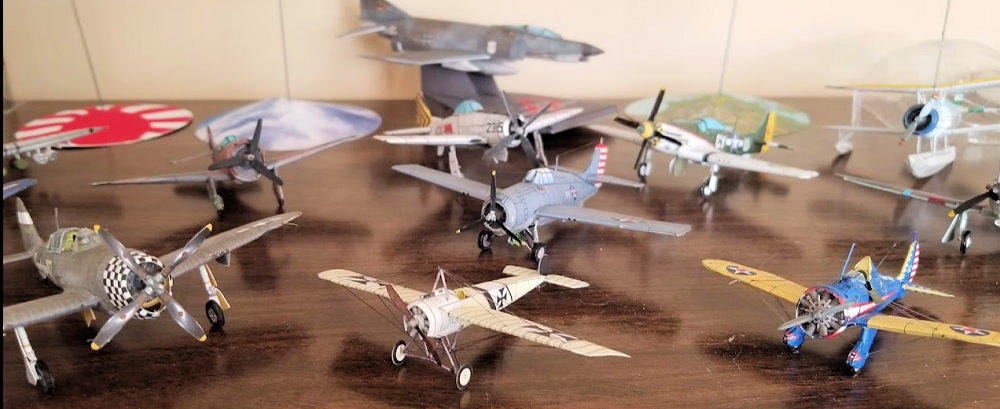

“Paper models of all types are popular in many countries. Called Paper-Card Modeling in Europe, it spans the range from simple folded-paper darts, to complex three-dimensional models of airplanes, ships and buildings.
During WWII, all materials were in short supply. Those that were available had restricted use. Obviously, toys were at the bottom of the list. These restrictions ruled out metal toys — wood and paper were about all that was available. The U.S. toymakers switched to toys and games that used paper and other non strategic materials. Even here, shortages of printing ink lead to some rather bizarre-colored paper models.
One style of paper-model construction used was developed by Wallis Rigby, an Englishman, who had moved his company to the U.S. in the late 1930s. Rigby was internationally known for his paper models of airplanes, boats and trains prior to WWII. These books featured Tab-and-Slot construction. He is generally credited with this method of paper-model construction.
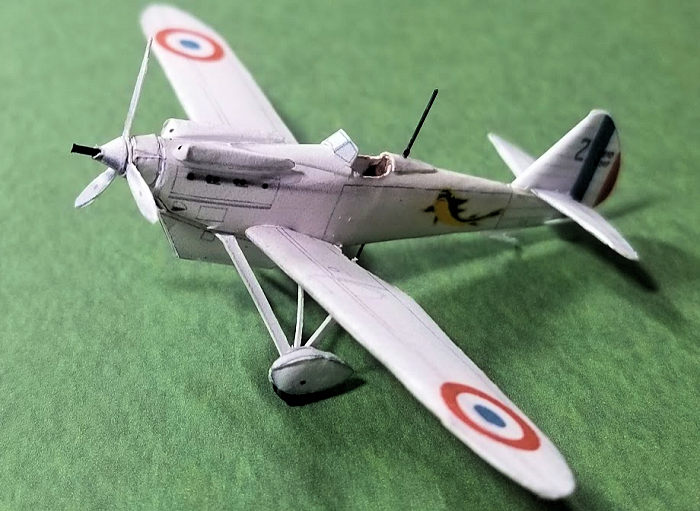 Rigby's realistic models gained much publicity during WWII. The wartime demand
for toys had to be met with non strategic materials. Paper models filled the
void. Rigby's models were published as individual books and boxed sets. And,
individual aircraft models, like the Douglas Dauntless, were published in
newspapers as part of the colored Sunday Comic Section. This product popularity
even led to Newsreel coverage of Rigby, showing the steps used to design, build
and fly one of his paper-model airplanes.
Rigby's realistic models gained much publicity during WWII. The wartime demand
for toys had to be met with non strategic materials. Paper models filled the
void. Rigby's models were published as individual books and boxed sets. And,
individual aircraft models, like the Douglas Dauntless, were published in
newspapers as part of the colored Sunday Comic Section. This product popularity
even led to Newsreel coverage of Rigby, showing the steps used to design, build
and fly one of his paper-model airplanes.
Cereal makers, too, felt the material-shortage pinch for premiums. Simplified paper-airplane models, similar to those of Rigby, were used as cereal premiums for General Mills in 1944. Mail in two box tops from Wheaties cereal and you received a pair of paper airplanes. General Mills gave away thousands of these models as part of a nation-wide contest. Backing this was a publicity campaign, showing Veterans in hospitals building the models. A contest held at Nebraska's Boy's Town garnered national Newsreel coverage, too. In all, paper-airplane models gave thousands of kids and adults their first try at model building.
After the end of WWII, material restrictions lifted and toy companies returned to making toys and models of metal, balsa wood and even some of the new plastics. Paper models rapidly disappeared from the U.S. Market. The now-common plastic models replaced the paper airplanes. Only a few publishers continued to print paper models.”
https://users.ece.cmu.edu/~koopman/airplanes/history.html
Paper Models and Me
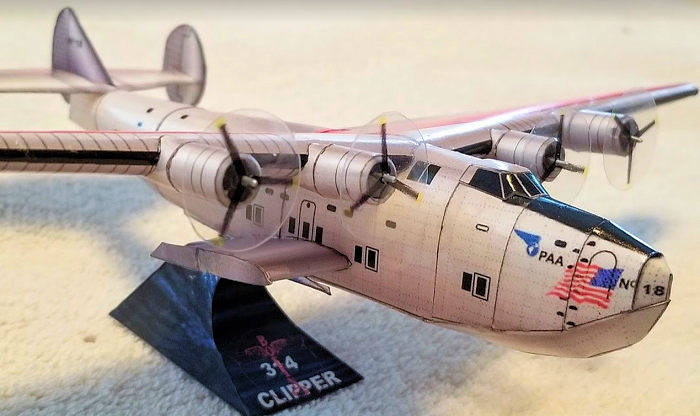 On February 2nd 1957 I started my career as a modeler. Easy to remember because
that was my eighth birthday. My first kit was the horrible box scale Revell
F-84F Thunderstreak. I remember leaving the party, running upstairs and building
it in about 20 minutes. Of course I didn't bother to read the instructions so I
just cut out the decals and glued them on. But that is another story.
On February 2nd 1957 I started my career as a modeler. Easy to remember because
that was my eighth birthday. My first kit was the horrible box scale Revell
F-84F Thunderstreak. I remember leaving the party, running upstairs and building
it in about 20 minutes. Of course I didn't bother to read the instructions so I
just cut out the decals and glued them on. But that is another story.
From that day until sometime in 2012 I built models pretty regularly. Mostly plastic but I also built stick & tissue Guillows, Comet and Cleveland. I even built two Guillows biplanes during my tour in Vietnam as a Loach pilot! I also did quite a bit of control line flying in the 1970's. I tell people I stopped in 2012 because by that time I had built every kit known to man!
Just about a year ago I discovered the amazing world of paper modeling. This is a thriving hobby all around the world. It has its roots in Eastern Europe during the Iron Curtain days when the borders were blocked for anything from the West. These kits were printed in a magazine format and were very popular in the late 1960’s to about 2000. At that time the kits went digital where distribution became easier with the advent of the internet. Now there are thousands of digital download kits available all over the internet. Many of them are free. Most are extremely inexpensive costing less than $20.00! A very well designed kits such as a B-17 is only about $12! Another example is ship models. From Poland I ordered a 1/400th USS Ward with an accompany Japanese mini sub, and a Catalina flying boat which also includes laser cut formers for a total of $32.00
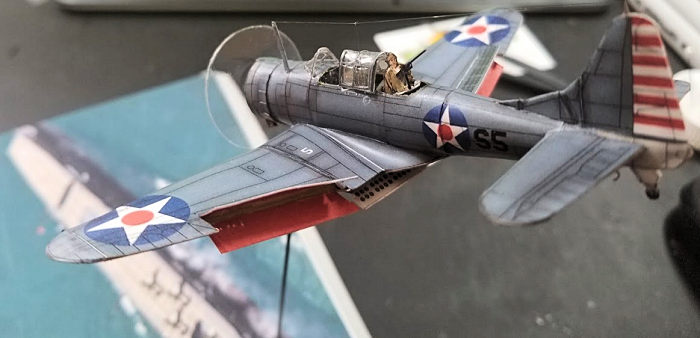 In November of 2017 I found
www.papermodelers.com
and numerous Facebook groups catering to paper modelers. My first foray into
paper was much like my first attempt at plastic all those many years ago. I
started off with probably the most difficult choice possible, a 1/33 P-26
Peashooter by a designer named Marek. Not a great first choice! By the time I
got to the wheel pants I learned the most important part of paper modeling. “If
you mess up just print out another one!”
In November of 2017 I found
www.papermodelers.com
and numerous Facebook groups catering to paper modelers. My first foray into
paper was much like my first attempt at plastic all those many years ago. I
started off with probably the most difficult choice possible, a 1/33 P-26
Peashooter by a designer named Marek. Not a great first choice! By the time I
got to the wheel pants I learned the most important part of paper modeling. “If
you mess up just print out another one!”
I did give up on the P-26 but did a much better job on a Nieuport 28 from a
designer Roman Vasilev who is now one of my good friends in the paper modeling
community. After this large scale build I discovered the world of 1/100 scale
paper kits. I also learned about the second rule of paper modeling “If you don’t
like the size print it to whatever size you wish!” SInce that time I have
specialized in 1/100th scale aircraft. I
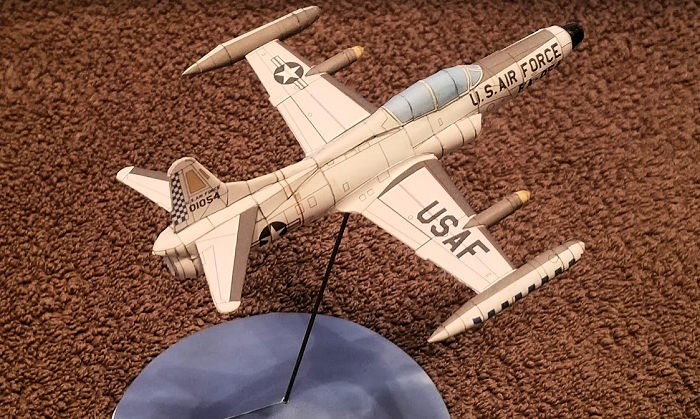 even did the P-26 that was a failure in
1/33rd in 1/100th and it turned out very good! I have built at least 50 kits in
the past year. Many I give away to young people who can display and enjoy them.
even did the P-26 that was a failure in
1/33rd in 1/100th and it turned out very good! I have built at least 50 kits in
the past year. Many I give away to young people who can display and enjoy them.
I have an engineer’s mentality so one of the things I really enjoy about paper models is modifying and reworking them to make the build better. I also enjoy the challenge of working to such a small size. But of course through the magic of math you can print them out at almost any size. There are even some who resize them to make flying radio control aircraft.
For tools you need only a very basic set of things such as an X-acto knife with good quality blades. A few assorted scissors or “squissors”. A nice metal straight edge. A circle template comes in very handy for making 2 dimensional things round. You will also quickly assemble an assortment of round things to help in rolling shapes. A set of “Mexuan Balls” allows you to do amazing shapes with what starts out as flat paper. Also clamps and even tiny clothes pins from the Dollar Store are very useful. The most popular glue is Aileens craft glue or even just plain old Elmers.
One thing that will keep harmony with SWMBO is that there is no odor with very
little painting required as all the markings, etc. are pre printed on the paper.
An investment in a good set of Derwent watercolor
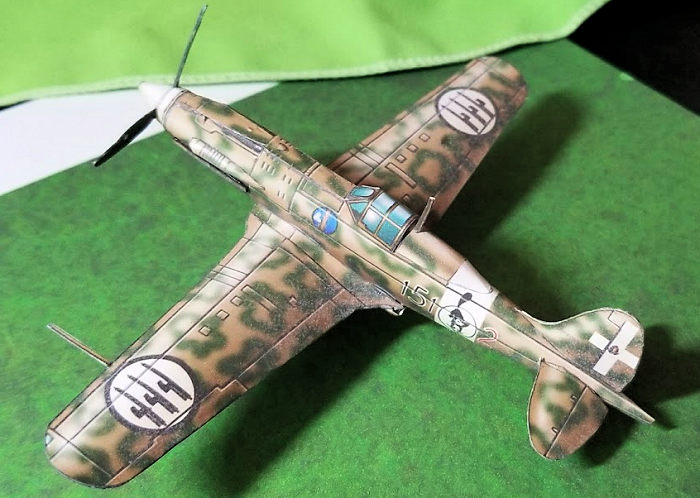 pencils or similar is all that
is required to color the edges of the paper before assembly.
pencils or similar is all that
is required to color the edges of the paper before assembly.
The types of models available boggle the mind. There are architectural homes and even entire towns. Animals that look very lifelike. Cars, mechanical devices such as clocks that actually work! The sky's the limit.
So if you are burned out on plastic kits or would just like to try something different come on over to www.papermodelers.com and check out the forum. On Facebook there are dozens of groups dedicated to paper modeling. There are many very friendly, helpful people and hardly any “ribbet kounters”!
29 October 2018
Copyright ModelingMadness.com
If you would like your product reviewed fairly and fairly quickly, please contact the editor or see other details in the Note to Contributors.
Back to the Main Page Back to the Review Index Page Back to the Previews Index Page